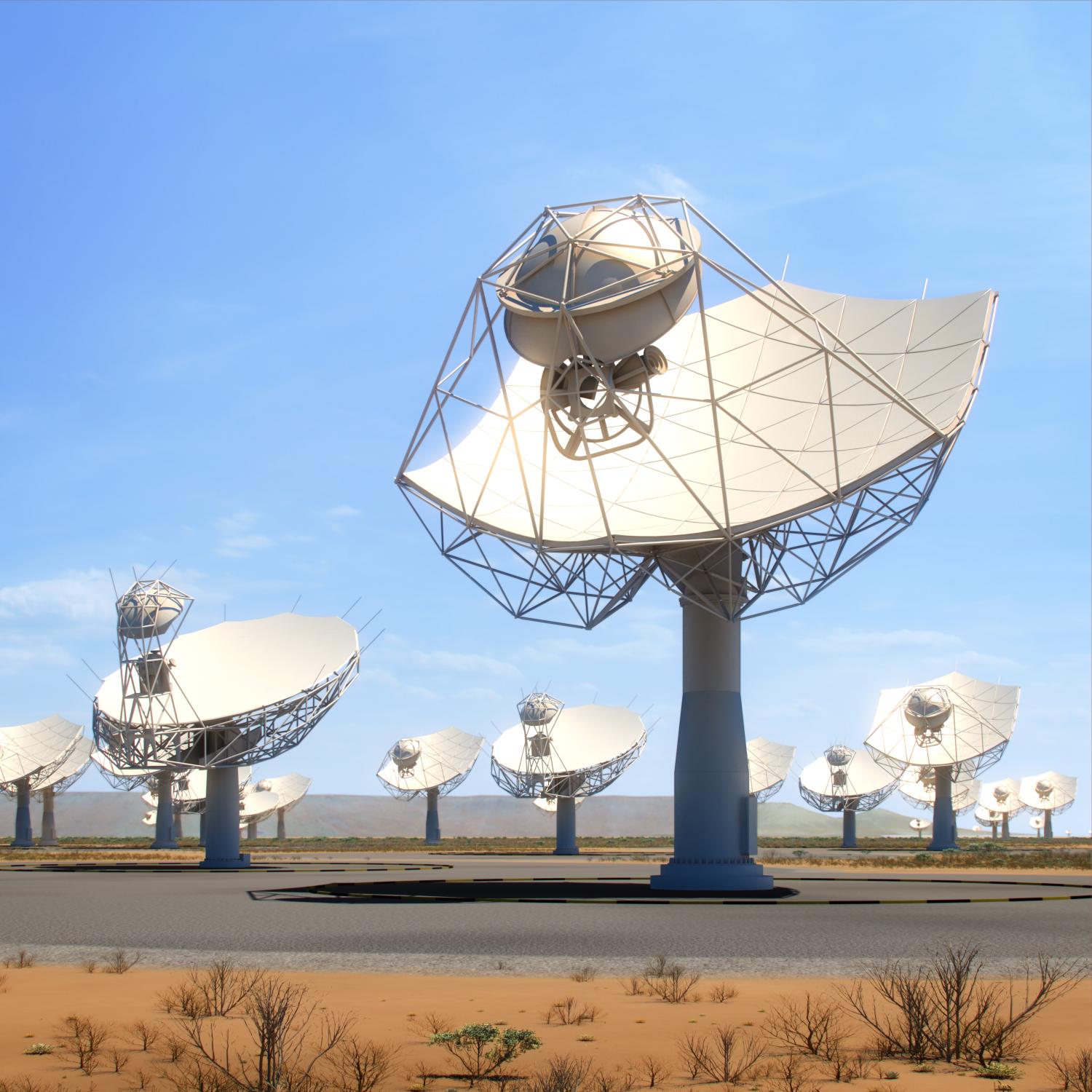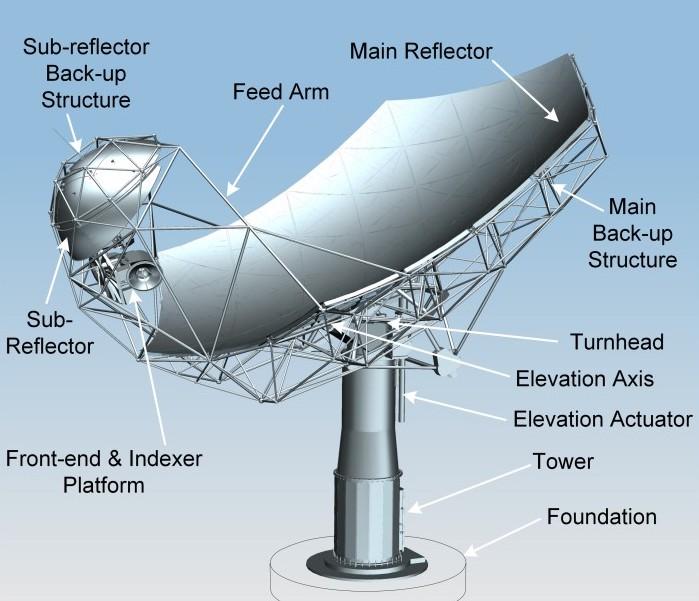SKA-Mid
Studying the cosmos from South Africa
SKA-Mid in numbers
Size: 197 fully steerable dishes, including the existing MeerKAT radio telescope
Collecting area: 33,000 m²
Maximum distance between dishes: 150 km
Frequency range: 350 MHz - 15.4 GHz, with a goal of 24 GHz
Rising from the ground in South Africa's Karoo region, the 197 parabolic dishes that form SKA-Mid will represent a new era of radio astronomy.
Conducting observations in many exciting areas of science, from timing pulsars and tracking gravitational waves, to searching for the signatures of life elsewhere in the galaxy, SKA-Mid will open up new windows into the Universe.
The existing MeerKAT radio telescope will form part of the array, its 13.5m-diameter dishes being joined by the slightly larger 15m-diameter SKA dishes, all integrated into one system.
From a central core measuring around 1km across, the antennas will radiate out in three spiral arms covering a vast distance; the two furthest antennas in SKA-Mid will be 150km apart.
Institutions in China, Australia, Canada, France, Germany, Italy, South Africa, Spain, the United Kingdom and Sweden all contributed to the SKA-Mid design, and the various components will be manufactured all over the globe before being shipped to South Africa for assembly.
How does it work?
The main reflector (the 15m-diameter dish surface) is made up of 66 individual panels, each of which has to be adjusted with sub-millimetre precision to ensure a smooth collecting surface. For SKA-Mid, the average surface accuracy is between 0.010 and 0.030mm – less than the width of a human hair. This level of precision is essential to ensure that radio waves from space are collected, and don't simply bounce off. Each of the individual panels measures 3m-a-side, and has its own specific curvature depending on its position on the surface.
The main reflector directs radio waves onto the sub-reflector, which is offset toward the bottom of the dish. The sub-reflector in turn directs the radio waves onto a receiver.
As SKA-Mid will observe a wide frequency range of 350 MHz to 15.4 GHz, it uses a several different receivers (also known as feeds) which are designed for different frequencies within the range. The receivers sit on hefty piece of hardware called a feed indexer, which moves the relevant receiver into place depending on the frequency being observed. The feed indexer has to support receivers which weigh upwards of 160kg each, and must be able to position them accurately to within fractions of a millimetre.
The receivers transform radio waves from analogue to digital, which enables the signals to be processed. Electromagnetic waves enter the first part of the receiver, known as the feed horn, and are turned into a signal which is sent on to a low-noise amplifier. As the name suggest, this boosts the very faint signal, but without adding too much noise/interference, similar to the process of enhancing a dark photo without making the whole thing look more blotchy and fuzzy. This stronger signal carries on down the receiver chain and is digitised so that it can be sent via optical fibre to the off-site processing facilities.

Seeing the sky in more detail
There are three key measures of a radio telescope's capabilities: resolution, sensitivity and survey speed. Compared to the current state-of-the-art telescopes in this frequency range, SKA-Mid will provide huge advances in all three areas.
Resolution: sharpening the view
SKA-Mid's 197 dishes will be configured with a dense central core of antennas, surrounded by three spiral arms which will radiate out from the core. The maximum distance (or baseline) between dishes will be 150km. Creating long baselines is a key component of interferometry, as it improves the resolution that telescopes can achieve. As with video streaming and photography in everyday life, in radio astronomy better resolution means you get a clearer, less fuzzy image, which allows astronomers to see greater detail in astronomical objects and phenomena.
Sensitivity: seeing more of the cosmos
As well as a clearer view, SKA-Mid will be able to see much fainter objects than is currently possible - this is a measure known as sensitivity in astronomy, and it depends on a telescope's collecting area. This is the area available for astronomical signals to be captured, so in the case of SKA-Mid it is the dish surfaces. As you add dishes to an array, the collecting area increases. With 197 dishes, SKA-Mid will have a collecting area 33,000m2 - equivalent to the area of 126 tennis courts!
Survey speed
Designing a telescope is a balancing act between competing requirements. A small number of large dishes could provide high sensitivity, but SKA-Mid also needs to carry out major surveys, scanning large regions of the sky. For this you need many smaller dishes which create a larger field of view (as they can look in different directions concurrently). This produces much faster survey speeds. For SKA-Mid the sweet spot was to adopt a design of 15m-diameter dishes which provide a good field of view while also still meeting the requirements for high sensitivity.
How does SKA-Mid compare?
Compared to the Karl G. Jansky Very Large Array (VLA) telescope in the United States, which is currently the best similar instrument in the world, SKA-Mid will have four times the resolution, five times the sensitivity and will be able to survey the sky 60 times faster.


Did you know?
SKA-Mid dishes are fully-steerable, equipped with a drive system that can point them with an accuracy of 1/3600th of a degree.
The whole dish structure stands at over 22m tall.
When fully loaded, the feed indexer weighs more than 2000kg.
Why not one big dish?
Picture a radio telescope. Perhaps what comes to mind is one huge "dish" mega-structure like China's Five-hundred-metre Aperture Synthesis Telescope (FAST), or the historic 305m-diameter Arecibo telescope in Puerto Rico. SKA-Mid's design is different; the SKA dishes are 'only' 15m in diameter, but their power comes from their number, and how the 197 dishes work together as an interferometer.
Design considerations
For both SKA telescopes, as with all major scientific infrastructures, science requirements were not the only issue when designing the structures. These had to be balanced with cost constraints, the feasibility of mass producing the dishes, installation speed, maintaining low operating costs, the ability to withstand environmental extremes like high winds or thermal stress, and many others. Finding the right balance, and ensuring every element met the SKAO's extremely stringent requirements, was a years-long process which is documented on our pre-construction design website.
Want to know more?
The SKA Construction Proposal contains many more technical details about the design and operation of both SKA telescopes.




